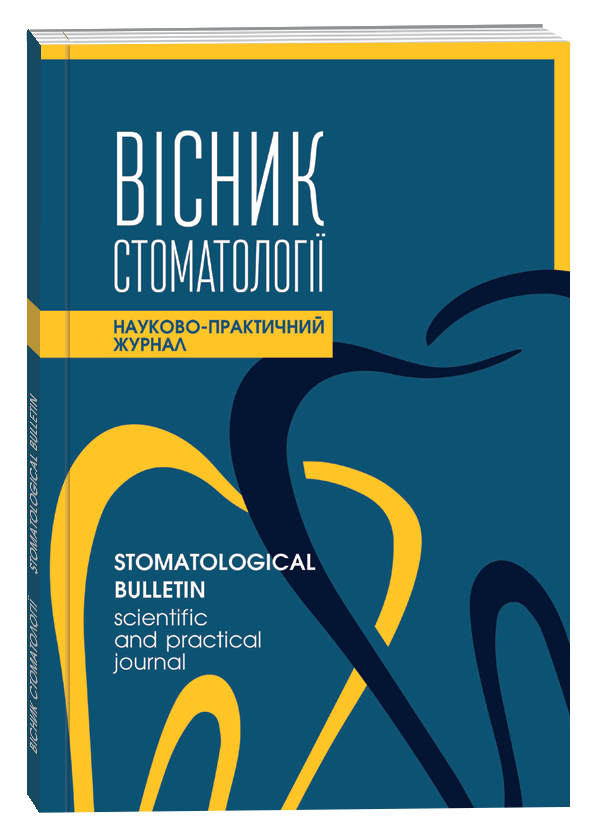ANOMALIES OF DENTITION IN THE STRUCTURE OF DENTOALVEOLAR ANOMALIES IN CHILDREN 7-18 YEARS OLD
Keywords:
dentoalveolar anomalies, prevalence, crowding, anomalies of dentitionAbstract
Purpose of research. Information on the prevalence and struc-ture of dentoalveolar anomalies will help to determine the need of the child population in orthodontic care and to calculate the volume of therapeutic and preventive measures. Therefore, information about the prevalence of anomalies of dentition re-quire constant updating.
Materials and methods. To determine the structure of dentoalveolar anomalies, we examined 346 patients aged 7-18 years living in the city of Odessa and Odessa region and seeking orthodontic care. All children were divided into 4 age groups according to the period of bite formation. The analysis of the obtained results was carried out according to the classification of D. A. Kalvelis, the combined pathology was not singled out separately.
Research result. The results of the studies showed that the struc-ture of dentoalveolar anomalies in different age periods is dif-ferent and dentoalveolar anomalies have a combined character.
In the structure of dentoalveolar anomalies prevailed cases pregnate. The smallest proportion of prognathia was recorded in the early changeable bite. In the late shift bite, it increased by more than 19.3 %. During the formation of a permanent bite and in a permanent bite, the frequency of prognathia was ap-proximately at the same level.
Deep bite was observed in 18.4 % of cases examined. Moreover, the largest number of children with deep bite is recorded in the early changeable bite, which can be explained by the frequent combination of deep bite with the growth of prognathia at the same age. The prevalence of deep bite in the late shift and dur-ing the formation of a permanent bite varies at the same level, and in the constant bite again grows sharply.
The frequency of open bite did not change with age. The highest frequency of oblique occlusion was observed in the late change-able occlusion.
Progeny was observed in 6.7 % of the cases surveyed and there was a tendency to increase with age surveyed children, possibly due to puberty.
Summary. The data obtained will help to determine the volume of therapeutic and preventive measures.
References
Хабилов Н.Л. Распространенность зубочелюстных аномалий у детей школьного возраста Бухарской области / Н.Л. Хабилов, Ш.Н. Нурова, Н.Б. Нуров // Международный журнал прикладных и фундаментальных исследований. – 2015. – № 12(9). – С. 1633-1634;
Burstone C.J. Physics and clinical orthodontics: 100 years ago and today / C.J. Burstone // Am J Orthod Dentofacial Orthop. – 2015. Mar. – 147(3). – Р. 293-4.
Chatzoudi M.I. Clinical effectiveness of the chin cup treatment for the management of class III malocclusion in the pre-pubertal patients: a systematic review and meta-analysis / M.I. Chatzoudi, I. Ioannidou-Marathitou, M.A. Papandopoulos // Prog Orthod. – 2014. Dec. – 2. – 15 p.
Clark W.J. Twin-block. Functional therapy. Applications in dentofacial orthopedics / W.J. Clark // Third edition. New Delhi, 2015. – 560 s.
De Clerck H.J. Growth modification of the face: A current perspective with emphasis on class III treatment / H.J. De Clerck, W.R. Proffit // Am J Orthod Dentofacial Orthop. – 2015. Jul. – 148(1). – 37-46 p.
Dean J. A. McDonald and Averyʼs dentistry for the child and adolescent, tenth edition / J.A. Dean // 2015. - ISBN: 978-0-323-28745-6 –700 s.
Krneta B. Diagnosis Class ΙΙΙ malocclusion in 7-to 8-yearold children – a 3-D evaluation / B. Krneta, A. Zhurov, S. Richmond and M. Ovsenik // European journal of Orthodontics. – 2015. –V. 37– №4. – Р.379-385.
Rossi M. Orthodontics in clinical practice / M. Rossi. – Published in the UK: Anshan Ltd. –2015. – 278 р.
Singh G. Textbook of orthodontics / G. Singh. – London: Third Edition, 2015. – 714 s. – ISBN: 978-93-5152-440-3.
Comparative study of torque expression among active and passive self-ligating and conventional brackets / É. M. Franco, F. P. Valarelli, J. B. Fernandes [et al.] // Dental Press J. Orthod. – 2015. – № 20 (6). – Р. 68-74.
Влияние своевременного пришлифовывания бугров временных клыков у детей на формирование зубочелюстных аномалий / O.S. Suslova, T. A. Agakisheva, E. G. Naretya G. M. Madyarova // East European Scientific Journal. – 2018. – №11(39). – P. 65-67









